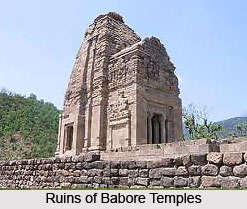 Babore temples house the ruins of 6-temple architecture within a radius of 1km is an imposing site of immense archaeological importance in the Indian state of Jammu and Kashmir. The temple site is about 50km away from Udhampur city in Dhar Road near Manwal in Udhampur district. Presently, the Babore temples are managed by the Archaeological Survey of India (ASI).
Babore temples house the ruins of 6-temple architecture within a radius of 1km is an imposing site of immense archaeological importance in the Indian state of Jammu and Kashmir. The temple site is about 50km away from Udhampur city in Dhar Road near Manwal in Udhampur district. Presently, the Babore temples are managed by the Archaeological Survey of India (ASI).
Architecture of Babore Temples
Imposing structure of the temple has immense archaeological importance with rich religious ancestry. These bear striking similitude to the temples built by King Lalitaditya, the ruler of Kashmir in 8th century A.D at Wangat in Kashmir. Sadly, ruins of only 3 temples have been identified till the present times. Among these, two are still used by the local residents for worship, which are dedicated to Lord Shiva and his consort Goddess Parvati. The stones, monolithic beams, pillars used for the construction are about 12 feet long, and their sculptures and carving are marvellous and impressive.
This article is a stub. You can enrich by adding more information to it. Send your Write Up to content@indianetzone.com





















